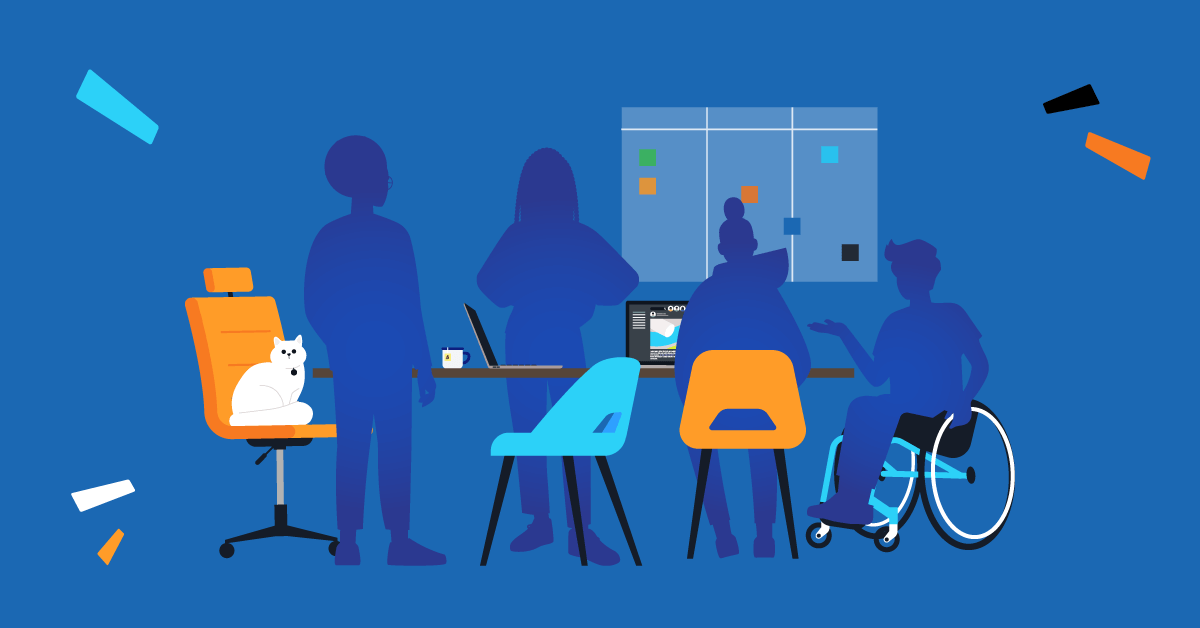Are you constantly hunting for the perfect talent, only to overlook the incredible potential already within your team? What if the solution to your hiring challenges has been right under your nose the whole time?
Internal mobility isn’t just about filling positions and skill gaps. It’s about unlocking hidden talent inside your company. This fuels growth as they already understand your culture, goals, and vision.
Why search elsewhere when the best fit might be sitting right in the next room?
Edie Goldberg discusses internal mobility and the treasures it brings for a business in “Hiring from within: The abundant talent that’s under your nose,” from TalentLMS’ podcast series, Keep it Simple.
Many businesses overlook the skills, experience, and potential of their employees. That’s why they rush to hire external talent every time a need for a particular skill arises. But if they focused on promoting from within, companies could grow their teams in smarter ways without wasting resources on the hiring process.
Enabling internal mobility is more than finding the top talent in your workforce. It also means helping people develop and stay motivated, ultimately create a more engaged and thriving workforce.
What is internal mobility?
Let’s start with a definition. Internal mobility is when employees move to new careers or development opportunities within the same organization. These employee mobility moves can be vertical or lateral—they’re not just limited to promotions.
This can be switching to a new department, getting a promotion, or taking on different projects to learn new skills. All of these help employees and businesses grow.
Instead of relying only on outside hires, internal hiring focuses on tapping into the potential of current employees, matching them with roles that align with their goals and ambitions.
Internal mobility is also known as “quiet hiring.” Quiet hiring is the practice of an organization acquiring new skills without hiring new full-time employees, according to Gartner. In brief, it’s all about making the most of what you already have.
Examples of internal mobility programs
Internal mobility can take many forms. Some common examples include:
- Promotions: People move up the ranks to take on greater responsibilities within the same department or another part of the organization.
- Lateral transfers: Employees shift to another department or function at the same organizational level to apply their experience and skill sets.
- Project-based opportunities: People temporarily work on a specific project outside their usual role, giving them the chance to gain new skills and put existing skills to use.
- Job shadowing: Employees observe colleagues in different departments to learn about other roles and possibly prepare for future transitions.
- Internal secondments: Short-term assignments in different departments to help people expand their network and experience without a permanent move.

Benefits of internal mobility
So why is internal mobility important? Are there any internal mobility benefits for the modern workplace? Supporting internal mobility creates advantages not only for the team members who are learning new skills and progressing in their careers but also for you as an employer.
Allowing for more mobility of employees strengthens your company and your hiring efforts by offering the following:
Easier recruitment and employee retention
People want to know they have options so their careers won’t stagnate. Allowing internal mobility shows employees (and prospective employees) that you support career mobility and are willing to invest in your workforce. Internal hiring is a benefit that attracts qualified candidates and engages current employees, and more engagement and employee satisfaction mean a boost to retention.
Faster and lower-cost hiring
Finding, recruiting, and onboarding new hires takes time and money. The average cost of onboarding one new employee is nearly $4,700—not to mention the cost of downtime as you wait to fill crucial roles. When you recruit from the inside, you cut down on the time and cost of typical outside hiring because you don’t need to sift through resumes and qualify new candidates. Instead, you bridge skills gaps faster by leveraging employees with existing company knowledge and experience.
Improved employee performance
Employees who feel supported and valued have a more positive outlook at work. Recognizing and encouraging team members’ goals is key to showing employees you appreciate them. And when people are allowed to transition to new roles or learn new skills through internal mobility programs, they’ll be more inspired to put forth their best efforts.
Smoother onboarding
When you hire internally, you’re dealing with employees who already know the company’s culture, system, and values. This allows people to hit the ground running, reducing onboarding and training time that would otherwise be needed for external hires. As your current employees already have the knowledge of how the company operates, they can focus on mastering the new role, not learning the ABCs.
As Goldberg put it, “You can actually get really important business-critical work done by leveraging the talent that you have inside.” Meaning, that with internal hires, the learning curve is shorter and results are quicker.
Better cultural fit
Cultural fit can be a big concern when hiring externally. Internal candidates, however, have already proven that they align with the company’s values. They’ve formed relationships and understand the company’s dynamics. Which makes them a safer bet. Internal hires reduce the risk of hiring someone who doesn’t gel with their team.
Goldberg says “it’s necessary to move managers from a mindset of talent scarcity to a mindset of abundance, where they see everyone in the company as a potential source for talent.”
Enhanced employee loyalty and motivation
Employees who feel supported and valued have a more positive outlook at work. Recognizing and encouraging team members’ goals is key to showing employees you appreciate them. And when people are allowed to transition to new roles or learn new skills, they are more likely to perform their best.
Goldberg underscores this with “Your employees really hate it when you go outside and hire a contractor… to do that really cool new project.” Companies shouldn’t ignore any existing employee. Instead, they should offer more internal mobility opportunities and reap the benefits of motivated and loyal employees.
Increased agility in response to business needs
Companies need to be agile in today’s business landscape that’s constantly changing. Internal hiring allows companies to allocate talent to areas most needed quickly. Whether this is filling skill gaps or tackling a new project, an internal mobility strategy allows the flexibility to adapt faster than if companies relied only on external hires.
Goldberg supports the idea that it’s easy and fast to discover which person has the adjacent skill needed or a similar one and upskill them. This quick adaptability keeps companies nimble in a fast-paced market. Assess your learners’ skills effectively and stress-free with the AI-powered tool, Skills. Design a customized assessment to validate employee abilities and knowledge.
Empowered L&D culture
Internal hiring also encourages a culture of growth and learning. Employees see that by acquiring new skills they can move up or across the company. This creates a desire for continuous learning that benefits both the employee and the company.
Individuals who feel they have room to grow through internal mobility are more engaged and less likely to leave. “The biggest reason employees leave their current employer is lack of access to career growth opportunities,” according to Goldberg. Offering internal career mobility, and upskilling and reskilling opportunities, transforms the company into a workplace where people want to invest in their personal and professional development.
Best practices for implementing an internal mobility program
For your internal mobility strategy to be successful, companies need a strategy that supports employee growth and business needs.
Let’s take a look at key practices that can guide organizations toward effective internal mobility.
1. Stop rushing to recruit externally
Before turning to external recruitment, look internally first. Often, the best fit for a new role is already within the organization, waiting for the opportunity to grow. Take stock of your existing talent. Identify who is ready for a challenge or who can be trained to take on a new role. Internal candidates come with built-in company knowledge, reducing transition time and increasing loyalty.
2. Shift from talent scarcity to talent abundance
Managers might worry about losing their top performers to other departments. But a culture of talent mobility benefits everyone.
By seeing talent as an abundant resource, organizations encourage collaboration and development across teams. This mindset shift promotes a healthier, growth-oriented environment where people are empowered to explore new roles without fear of stagnation.
Goldberg highlights “Move managers from a mindset of talent scarcity, where they hoard talent, to one of abundance, where they see all employees as potential resources.”
3. Reward talent exports
To encourage internal mobility, companies can reward managers who help their team members grow by moving into roles within the organization. When managers are recognized for fostering development and supporting internal transfers, it creates a positive feedback loop that encourages more managers to do the same, making mobility part of the company culture.
“Companies like Adobe recognize and reward managers for being ‘net talent exporters.’ This means supporting employee development and sharing talent across the organization is celebrated,” Goldberg supports.
4. Provide learning and development opportunities
Talent mobility isn’t just about promotions or transfers, as we’ve mentioned before. People need to be offered continuous learning opportunities. This can be in the form of upskilling and reskilling programs, project-based learning, or short-term assignments that allow individuals to develop new skills. As employees broaden their expertise without leaving the company, they feel more engaged and invested in their roles.
5. Democratize access to opportunities
“Creating a level playing field ensures that every employee, regardless of their background, has equal access to training and development programs,” Goldberg mentions.

When everyone has equal opportunities to grow, your internal mobility strategy flourishes.
Organizations must ensure that development programs and internal roles are accessible to everyone, not just a select few. This doesn’t only boost engagement and employee satisfaction but also fosters a more diverse and inclusive workplace where everyone has the chance to succeed.
6. Use talent marketplace technology
Talent marketplace platforms help bridge the gap between available roles and internal candidates. These platforms allow companies to match employees’ skills and aspirations with open opportunities, facilitating internal mobility programs.
By using such technology for talent acquisition, companies can tap into hidden talent, providing employees with new opportunities that align with both personal growth and business needs.
7. Keep it simple
“Don’t make it about politics. Don’t over-engineer it,” Goldberg advises.
Internal mobility programs and processes should be straightforward. Overcomplicating policies or creating too many hurdles discourages employees from taking advantage of internal opportunities.
Keep the system simple, transparent, and accessible to everyone. The easier it is for employees to explore internal moves, the more likely they are to engage with the process and seize new opportunities.
How to jump-start internal mobility in your organization
Are you ready to implement internal mobility in your organization? Start by taking the following steps:
Evaluate existing talent. Conduct a skills analysis to identify where an existing employee could fill existing gaps.
- Develop training programs. Offer upskilling and reskilling opportunities to help people prepare for new roles.
- Create a transparent process. Ensure that internal opportunities are advertised widely, and encourage employees to apply.
- Motivate managers. Encourage managers to support employee development and reward those who contribute to an internal mobility program.
- Adopt technology. Invest in platforms that help match employees with new opportunities based on their skills and career goals.
Challenges of internal talent mobility
While internal mobility offers countless benefits, the are challenges to implementing it effectively.
Lack of standardized processes
Some companies find it hard to establish clear and formal processes for internal mobility. Without a standardized system, employees may struggle to navigate internal job openings or transition between roles.
The lack of structure can lead to confusion, inefficiency, and missed opportunities. Companies with ad-hoc systems risk losing valuable internal talent to competitors simply because the internal move process isn’t transparent or accessible.
Managerial resistance
Managers often become protective of high-performing employees. They fear the loss of key talent and how negatively it might impact their team’s performance. This resistance can limit internal mobility opportunities, as managers may discourage or block their employees from pursuing roles elsewhere in the company. In such cases, employees may feel trapped. Which could ultimately lead to disengagement or resignation.
Limited internal talent pool
Even with a strong focus on an internal mobility program, companies may not always have the skills they need within their entire workforce. Some roles require specialized knowledge or experience. Which means it might be necessary to turn to external hiring.
While internal mobility helps with retention and career development, it can’t always fill every skill gap. Oorganizations must balance internal promotions of their existing employees with external recruitment.
Risk of stagnation
Even if talent mobility promotes career development opportunities for your existing employees, it can also lead to a sense of stagnation. Employees who move from one internal role to another might become too comfortable with the company’s culture, practices, and routines.
Without the fresh perspectives external hires bring, innovation can slow, and the company may struggle to adapt to industry changes. External hires often bring new ideas and challenge the status quo, which is essential for continuous improvement.
Learning curve for new roles
Even when employees transition within the same company, there’s always a learning curve involved with internal mobility.
Moving to a new department or role requires new skills or an adjustment to different workflows and processes. Even if internal hires have an understanding of company culture and practices, they still need time to adapt. And this adjustment period can temporarily slow down productivity.
Enabling internal mobility has never made more sense
Hiring from within is the best way to boost employee engagement, promote loyalty, and tap into talent that already understands your company’s ways.
While there are challenges to overcome with internal talent acquisition, creating a clear path for internal mobility can unlock the potential of your existing workforce. And drive both individual growth and organizational success.
Embracing internal hiring isn’t just smart. It’s essential for a thriving, dynamic business.
Originally published on: 08 Dec 2022 | Tags: hiring,Talent Retention





